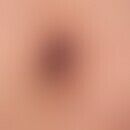Synonym(s)
Bean Syndrome; Blue rubber bleb nevus syndrome; Blue rubber vesicle nevus syndrome; BRBNS; Hemangiomatosis viscerocutaneous; viscocutaneous hemangiomatosis
HistoryThis section has been translated automatically.
Gaskoyen, 1860; Bean, 1958
DefinitionThis section has been translated automatically.
- Very rare (about 200 cases in world literature), autosomal dominant inherited, but also sporadically occurring, androtropic vascular malformation with multiple angiomas of the skin and various internal organs. Predominantly blind courses, very rarely fulminant or fatal forms.
- The autonomy as an entity is doubted by some authors because of the clinical consistency with generalized glomangiomatosis despite different histology and etiology.
You might also be interested in
EtiopathogenesisThis section has been translated automatically.
Mutations of the gene VMCM, TIE2, mapped on gene locus 9q21, with consecutive disruption of the receptor tyrosine kinase TIE-2.
ManifestationThis section has been translated automatically.
Childhood or early adulthood.
LocalizationThis section has been translated automatically.
On the whole integument, also on the oral mucosa (hard palate, cheek mucosa).
Clinical featuresThis section has been translated automatically.
- Integument: A few or up to more than 100 different sized, blue-black, subcutaneous or cutaneous, sharply defined papules or knots of soft to rubbery (naming!) consistency. In some cases the papules can be completely compressed.
- Oral mucosa: Angiomatous lesions are possible both on the hard palate and in the area of the buccal mucosa.
- Extracutaneous manifestations: Often angiomas in the gastrointestinal tract (especially stomach, intestine) with risk of bleeding. Angiomas in liver, spleen, gallbladder, kidney, pleura, lung, CNS and muscles are described (mostly asymptomatic, are only detected in the course of extensive diagnostics).
HistologyThis section has been translated automatically.
Mostly cavernous, more rarely capillary hemangiomas.
DiagnosisThis section has been translated automatically.
Blood count (anaemia?), haemoccult test, possibly gastroscopy and colonoscopy, upper abdomen sonography.
Differential diagnosisThis section has been translated automatically.
Complication(s)This section has been translated automatically.
Severe intestinal bleeding (deaths are known).
TherapyThis section has been translated automatically.
- No causal therapies known.
- Clarification of mainly gastrointestinal organ involvement; regular monitoring and, if necessary, symptomatic operative treatment in cooperation with surgeons and internists.
- An individual case report exists about the use of "low-dose sirolimus" as anti-angiogenetic principle. Below this, regression of existing intestinal bleedings.
- Skin alterations can be removed surgically or by laser.
LiteratureThis section has been translated automatically.
- Apak H et al (2004) Blue rubber bleb nevus syndrome (BRBNS) associated with consumption coagulopathy: treatment with interferon. Dermatology 208: 345-348
- Bean WB (1958) Vascular spiders and related lesions of the skin. Charles C. Thomas (ed.), Springfield (IL), pp. 178-185
- Bedocs PM et al (2003) Blue rubber-bleb nevus syndrome: a case report. Cutis 71: 315-318
- Gaskoyen G (1860) Case of naevus involving the parotid gland, and causing death from suffocation: neavi of the viscera. Transactions of the Pathological Society of London 11: 267
- Moser CM et al(2012) Successful treatment of cutaneous venous malformations in a patient with blue rubber bleb naevus syndrome by Nd:YAG laser. Br J Dermatol 66:1143-1145
- Rice JS et al (1962) Blue rubber bleb nevus syndrome. Arch Dermatol 86: 503-511
- Yuksekkaya H et al (2012) Blue rubber bleb nevus syndrome: successful treatment with sirolimus. Pediatrics 129: 1080-1084
Outgoing links (6)
Angioma; Fabry's disease; Glomangiomatosis generalized; Hereditary haemorrhagic telangiectasia; Kasabakh-merritt syndrome; Maffucci syndrome;Disclaimer
Please ask your physician for a reliable diagnosis. This website is only meant as a reference.





